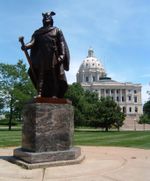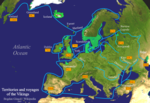Leif Ericson
2007 Schools Wikipedia Selection. Related subjects: Geographers and explorers
Leif Ericson ( Old Norse: Leifr Eiríksson) ( c. 980 – c. 1020) was an Icelandic/Norwegian explorer and the first European thought to have landed in North America—more specifically, the region that would become Newfoundland and, by later extension, Canada. His exploration resulted in several settlements, with some evidence suggesting that later Norsemen may eventually have penetrated as far as Minnesota, either coming down from Hudson Bay or going west through the Great Lakes.
The Saga of Leif Ericson the Viking
Early life in Iceland
It is believed that Leif was born about 980 in Iceland, the second son of Erik the Red ( Old Norse: Eiríkr rauði), a Norwegian-Icelandic explorer and outlaw and himself the son of another Norwegian outlaw, Þorvaldr Ásvaldsson. Leif's mother was Thorhild (Þjóðhildr). Erik the Red had founded two Norse colonies in Greenland, the Western Settlement and the Eastern Settlement, as he had named them. Apparently, Leif Ericson had two brothers, Þorvaldr and Þorsteinn, and one half-sister, Freydís. Leif married a woman named Þórgunnr, and they had one son, Þorkell Leifsson.
Exploration west of Greenland
During a stay in Norway, Leif converted to Christianity, like many Norse of that time. He also went to Norway to serve the King of Norway, Olaf Tryggvason. When he returned to Greenland, he bought the boat of Bjarni Herjólfsson and set out to explore the land that Bjarni had found (located west of Greenland), which was, in fact, the mainland of North America.
The Saga of the Greenlanders tells that Leif set out about 1000 to follow Bjarni's route with 35 crew members, but in the opposite direction.
Helluland and Markland
The first land he encountered was covered with flat rocks (Old Norse: hellur). He therefore called it Helluland ("Land of the Flat Stones"). Probably it was the present day Baffin Island. Next he came to a land that was flat and wooded, with white sandy beaches. He called Markland ("Wood-land"), and it is usually assumed to have been Labrador.
Settlement in Vinland
When Leif and his crew left Markland and found land again, they landed and built some houses. They found the area pleasant: there were plenty of salmon in the river and the climate was mild, with little frost in the winter and green grass year-round. They remained at this place over the winter. The sagas mention that one of Leif's men, Tyrkir, possibly a German, found wild grapes, and that Leif accordingly named the country Vínland after them.
On the return voyage, Leif rescued an Icelandic castaway named Þórir and his crew — an incident that earned Leif the nickname 'Leif the Lucky' (Old Norse: Leifr hinn heppni).
The L'Anse aux Meadows discovery
Research done in the 1950s and 1960s by explorer Helge Ingstad and his wife, archaeologist Anne Stine, strongly suggests that the settlement of Leif Ericson and his party in Vínland was actually at the tip of Newfoundland, later known as L'Anse aux Meadows.
Leif Erikson Day
In 1964, President of the United States Lyndon B. Johnson declared October 9 to be " Leif Erikson Day" in the United States.

